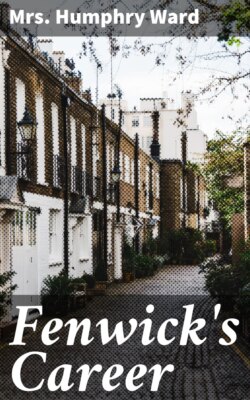Читать книгу Fenwick's Career - Mrs. Humphry Ward - Страница 11
На сайте Литреса книга снята с продажи.
INTRODUCTION
ОглавлениеTable of Contents
Fenwick's career was in the first instance suggested by some incidents in the life of the painter George Romney. Romney, as is well known, married a Kendal girl in his early youth, and left her behind him in the North, while he went to seek training and fortune in London. There he fell under other influences, and finally under the fascinations of Lady Hamilton, and it was not till years later that he returned to Westmoreland and his deserted wife to die.
The story attracted me because it was a Westmoreland story, and implied, in part at least, that setting of fell and stream, wherein, whether in the flesh or in the spirit, I am always a willing wanderer. But in the end it really gave me nothing but a bare situation into which I had breathed a wholly new meaning. For in Eugénie de Pastourelles, who is Phoebe's unconscious rival, I tried to embody, not the sensuous intoxicating power of an Emma Hamilton, but those more exquisite and spiritual influences which many women have exercised over some of the strongest and most virile of men. Fenwick indeed possesses the painter's susceptibility to beauty. Beauty comes to him and beguiles him, but it is a beauty akin to that of Michel Angelo's 'Muse and dominant Lady, spirit-wed'—which yet, for all its purity, is not, as Fenwick's case shows, without its tragic effects in the world.
On looking through my notes, I find that this was not my first idea. The distracting intervening woman was to have been of a commoner type, intellectual indeed rather than sensuous, but yet of the predatory type and class, which delights in the capture of man. When I began to write the first scene in which Eugénie was to appear, she was still nebulous and uncertain. Then she did appear—suddenly!—as though the mists parted. It was not the woman I had been expecting and preparing for. But I saw her quite distinctly; she imposed herself; and thenceforward I had nothing to do but to draw her.
The drawing of Eugénie made perhaps my chief pleasure in the story, combined with that of the two landscapes—the two sharply contrasted landscapes—Westmoreland and Versailles, which form its main background. I find in a note-book that it was begun 'early in May, 1905, at Robin Ghyll. Finished (at Stocks) on Tuesday night or rather Wednesday morning, 1 A.m., Dec. 6, 1905. Deo Gratias!' And an earlier note, written in Westmoreland itself, records some of the impressions amid which the first chapters were written. I give it just as I find it:
'The exquisiteness of the spring. The strong-limbed sycamores with their broad expanding leaves. The leaping streams, and the small waterfalls, white and foaming—the cherry blossom, the white farms, the dark yews which are the northern cypresses—and the tall upstanding firs and hollies, vigorously black against the delicate bareness of the fells, like some passionate self-assertive life. …
'The "old" statesman B——. His talk of the gentle democratic poet who used to live in the cottage before us. "He wad never täak wi the betther class o' foak—but he'd coom mony a time, an hae a crack wi my missus an me."
'The swearing ploughman that I watched this morning—driving his plough through old pastures and swearing at the horse—"Dang ye! Darned old hoss! Pull up, will ye—pull up, dang ye!"
'Elterwater, and the soft grouping of the hills. The blue lake, the woods in tints of pale green and pinkish brown, nestling into the fells, the copses white with wind flowers. Everywhere, softness and austerity side by side—the "cheerful silence of the fells," the high exhilarating air, dark tortured crags and ghylls—then a soft and laughing scene, gentle woods, blue water, lovely outlines, and flower-carpeted fields.
'The exquisite colour of Westmoreland in May! The red of the autumn still on the hills—while the bluebells are rushing over the copses.'
The little cottage of Robin Ghyll, where the first chapters were written, stands, sheltered by its sycamore, high on the fell-side, above the road that leads to the foot of the Langdale Pikes. But—in the dream-days when the Fenwicks lived there!—it was the old cottage, as it was up to ten or fifteen years ago;—a deep-walled, low-ceiled labourer's cottage of the sixteenth century, and before any of the refinements and extensions of to-day were added.
The book was continued at Stocks, during a quiet summer. Then with late September came fatigue and discouragement. It was imperative to find some stimulus, some complete change of scene both for the tale and its writer. Was it much browsing in Saint-Simon that suggested to me Versailles? I cannot remember. At any rate by the beginning of October we were settled in an apartment on the edge of the park and a stone's throw from the palace. Some weeks of quickened energy and more rapid work followed—and the pleasures of that chill golden autumn are reflected in the later chapters of the book. Each sunny day was more magnificent than the last. Yet there was no warmth in the magnificence. The wind was strangely bitter; it was winter before the time. And the cold splendour of the weather heightened the spell of the great, dead, regal place; so that the figures and pageants of a vanished world seemed to be still latent in the sharp bright air—a filmy multitude.
This brilliance of an incomparable décor followed me back to Hertfordshire, and remained with me through winter days. But when the last pages came, in December, I turned back in spirit to the softer, kinder beauty amid which the little story had taken its rise, and I placed the sad second spring of the two marred lives under the dear shelter of the fells.
